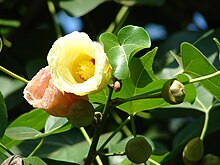
Hibiscus is a genus of flowering plants in the mallow family, Malvaceae. The genus is quite large, comprising several hundred species that are native to warm temperate, subtropical and tropical regions throughout the world. Member species are renowned for their large, showy flowers and those species are commonly known simply as "hibiscus", or less widely known as rose mallow. Other names include hardy hibiscus, rose of sharon, and tropical hibiscus.

Thespesia populnea, commonly known as the portia tree, Pacific rosewood, Indian tulip tree, or milo, among other names, is a species of flowering plant belonging to the mallow family, Malvaceae. It is a tree found commonly on coasts around the world. Although it is confirmed to be native only to the Old World tropics, other authorities consider it to have a wider, possibly pantropical native distribution. It is thought to be an invasive species in Florida and Brazil.
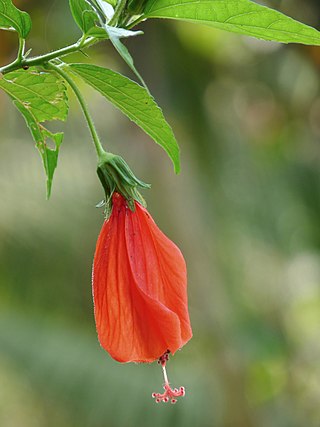
Malvaviscus is a genus of flowering plants in the mallow family, Malvaceae. Common names for species in this genus include Turk's cap mallow, wax mallow, sleeping hibiscus, and mazapan. It belongs to a group of genera that differ from the closely related Hibiscus in possessing a fruit divided into 5 separate parts, and having a style surmounted by 10, rather than 5, capitate or capitellate stigmas. Among those genera Malvaviscus is distinguished by having auriculate petals and red, fleshy fruits. The generic name is derived from the Latin words malva, meaning "mallow," and viscus, which means "sticky," referring to the mucilaginous sap produced by members of the genus. The fruit can be used to make jelly or syrup. Both the fruit and flowers are used to make herbal teas.

Hibiscus tiliaceus, commonly known as the sea hibiscus or coast cottonwood, is a species of flowering tree in the mallow family, Malvaceae, with a pantropical distribution along coastlines. It has also been introduced to Florida and New Zealand. It has been debated whether this species is native or introduced to Hawaii.

Thespesia grandiflora is a tree in the family Malvaceae of the rosids clade. Its common name is maga and sometimes is referred to as Maga Colorada and Puerto Rican hibiscus. This tree is widely distributed throughout Puerto Rico where it is endemic. Although originally endemic to the humid mountains of limestone in the western and north-central portions of the Island, today it grows everywhere in Puerto Rico due to its extensive cultivation. It is also grown as an ornamental tree in Florida, Hawaii, Honduras and in various Caribbean islands. The maga is mostly used as an ornamental plant, but like the related Thespesia populnea its wood is also valued for its durable timber. The flower was declared the national symbol of Puerto Rico on August 7, 2019.

Colubrina is a genus of about 30 species of flowering plants in the family Rhamnaceae, native to warm temperate to tropical regions of Africa, the Americas, southern Asia, northern Australia, and the Indian Ocean islands.
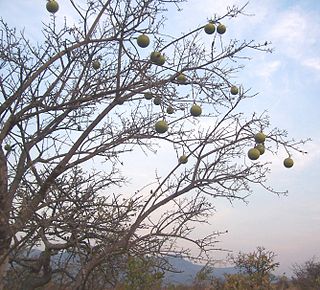
Strychnos spinosa, the Natal orange, also called Mokotra in Madagascar, is a tree indigenous to tropical and subtropical Africa. It produces sweet-sour, yellow fruits, containing numerous hard brown seeds. Greenish-white flowers grow in dense heads at the ends of branches. The fruits tend to appear only after good rains. It is related to the deadly Strychnos nux-vomica, which contains strychnine. The smooth, hard fruit are large and green, ripen to yellow colour. Inside the fruit are tightly packed seeds, which may be toxic, surrounded by a fleshy, brown, edible covering.

Intsia is a genus of flowering plants in the family Fabaceae. It includes two species which range from eastern Africa and Madagascar to India, Indochina, Malaysia, Papua New Guinea, northern Australia, and the south Pacific. They are trees which grow up to 40 (–45) meters tall, often buttressed, evergreen and unarmed. Typical habitat is humid tropical lowland forest including coastal forest on sand, rain forest, mangrove fringes and tidal river mouths, and occasionally inland on hills.
Thespesia cubensis is a species of flowering plant in the family Malvaceae. It is found only in Cuba. It is threatened by habitat loss.

Melhania is a genus of small shrubs or herbaceous plants. Traditionally included in the family Sterculiaceae, it is included in the expanded Malvaceae in the APG and most subsequent systematics. The genus is named for Mount Melhan in Yemen.

Hibiscus diversifolius, the swamp hibiscus, is a widespread species of hibiscus. It grows to between 1 and 2 metres in height, with prickly stems and yellow flowers with a maroon basal spot during spring summer.
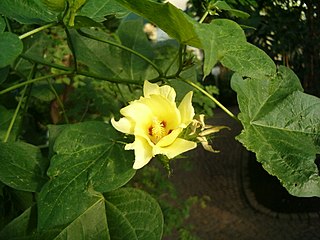
Gossypieae is a tribe of the flowering plant subfamily Malvoideae. It includes the cotton (Gossypium) and related plants. It is distinguished from the Hibisceae on the basis of embryo structure and its apparently unique possession of glands able to synthesize the pigment gossypol.

Talipariti is a genus of plants in the mallow family Malvaceae. It consists of 22 species, which are exclusively tropical except for one species whose range extends into temperate areas of Japan and Korea. Most authors now treat these species as part of the genus Hibiscus, in which case they form the section Hibiscus sect. Azanzae.

Hibisceae is a tribe of flowering plants in the mallow family Malvaceae, subfamily Malvoideae.

Schizachyrium is a widespread genus of plants in the grass family. The name is derived from the Ancient Greek words σχίζειν, meaning "to split," and ἄχυρον, meaning "chaff." It refers to either the glume or the toothed lemmas.

Radyera is a genus of flowering plants in the family Malvaceae.
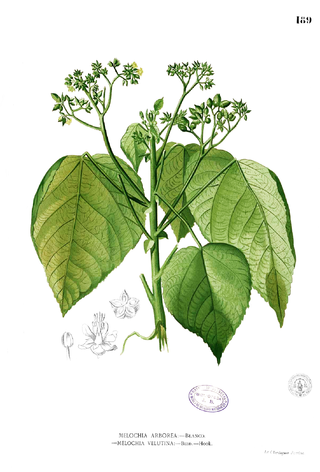
Melochia is a genus of flowering plants in the mallow family, Malvaceae. It comprises 54 species from the tropical and subtropical regions of the world, ranging from India eastwards through Malesia and the Pacific Islands to the Americas and the Caribbean.

Crateva is a genus of flowering plants in the caper family, Capparaceae. It includes 21 species which range through the tropical regions of the world, including the tropical Americas, sub-Saharan Africa, the Indian subcontinent, Indochina, southern China, Japan, Malesia, Papuasia, Queensland, and the South Pacific.

Croton gratissimus, is a tropical African shrub or small tree with corky bark, growing to 8 m and belonging to the family of Euphorbiaceae or spurges. Young twigs are slender and angular and covered in silver and rust-coloured scales.
